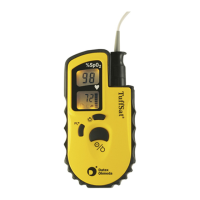Oximeter Features and Use
2-5
Using the oximeter
WARNING: Patient safety.
• This device is not intended for use in a magnetic resonance imaging (MRI)
environment.
• To prevent patient injury or equipment damage, use only Datex-Ohmeda
sensors approved for use with this oximeter. For complete information about
the safe and appropriate use of a sensor, consult the instructions for that
sensor.
WARNING: Data validity. To prevent erroneous readings, do not use an inflated
blood pressure cuff or arterial blood pressure measurement device on the same
limb as the oximeter sensor.
1. Apply the sensor to the patient and connect it to the oximeter. Refer to the
instructions for the sensor you are using.
2. Press the on/off button to power on the oximeter.
After completing the brief self-test, the oximeter detects the SpO
2
and pulse rate
values and monitoring begins.
3. Verify that the signal strength is adequate and that the data agree with your
clinical evaluation of the patient. See Data validity and signal strength later in
this chapter.
If the oximeter fails to function as described, refer to Troubleshooting in chapter 3.
WARNING: Patient safety.
• When the display indicates an error condition or the oximeter appears to be
operating abnormally, disconnect the sensor immediately.
• Patient conditions (such as reddening, blistering, skin discoloration, ischemic
skin necrosis, and skin erosion) may warrant changing the site frequently or
using a different style of sensor.
• Discard a damaged sensor immediately. Do not repair a damaged sensor or use
a sensor repaired by others.
• When the battery becomes depleted, the oximeter shuts off. No alarm sounds.
WARNING: Data validity. Conditions that may cause inaccurate readings include
interfering substances, excessive ambient light, electrical interference, excessive
motion, low perfusion, low signal strength, incorrect sensor placement, poor sensor
fit, and movement of the sensor on the patient.
WARNING: Failure of operation. It is possible for any device to malfunction;
therefore, always verify unusual data by performing a formal patient assessment.

